Abstract
This study was designed to examine the antileishmanial activity of the oxygenated chalcone licochalcone A in mice and hamsters infected with Leishmania parasites. Intraperitoneal administration of licochalcone A at doses of 2.5 and 5 mg/kg of body weight per day completely prevented lesion development in BALB/c mice infected with Leishmania major. Treatment of hamsters infected with L. donovani with intraperitoneal administration of licochalcone A at a dose of 20 mg/kg of body weight per day for 6 consecutive days resulted in a > 96% reduction of parasite load in the liver and the spleen compared with values for untreated control animals. The [3H]thymidine uptake by the parasites isolated from the treated hamsters was only about 1% of that observed in parasites isolated from the controls. Oral administration of licochalcone A at concentrations of 5 to 150 mg/kg of body weight per day for 6 consecutive days resulted in > 65 and 85% reductions of L. donovani parasite loads in the liver and the spleen, respectively, compared with those of untreated control hamsters. These data clearly demonstrate that licochalcone A is a promising lead for the development of a new drug against leishmaniases.
Full text
PDF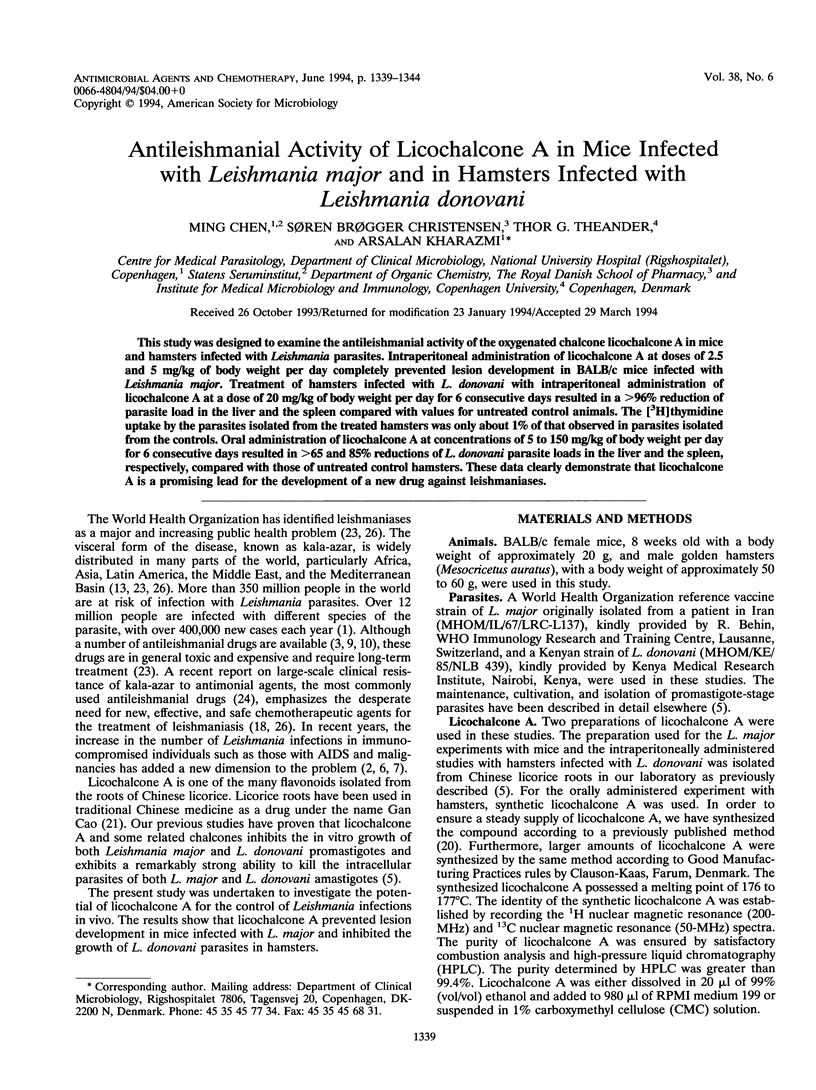
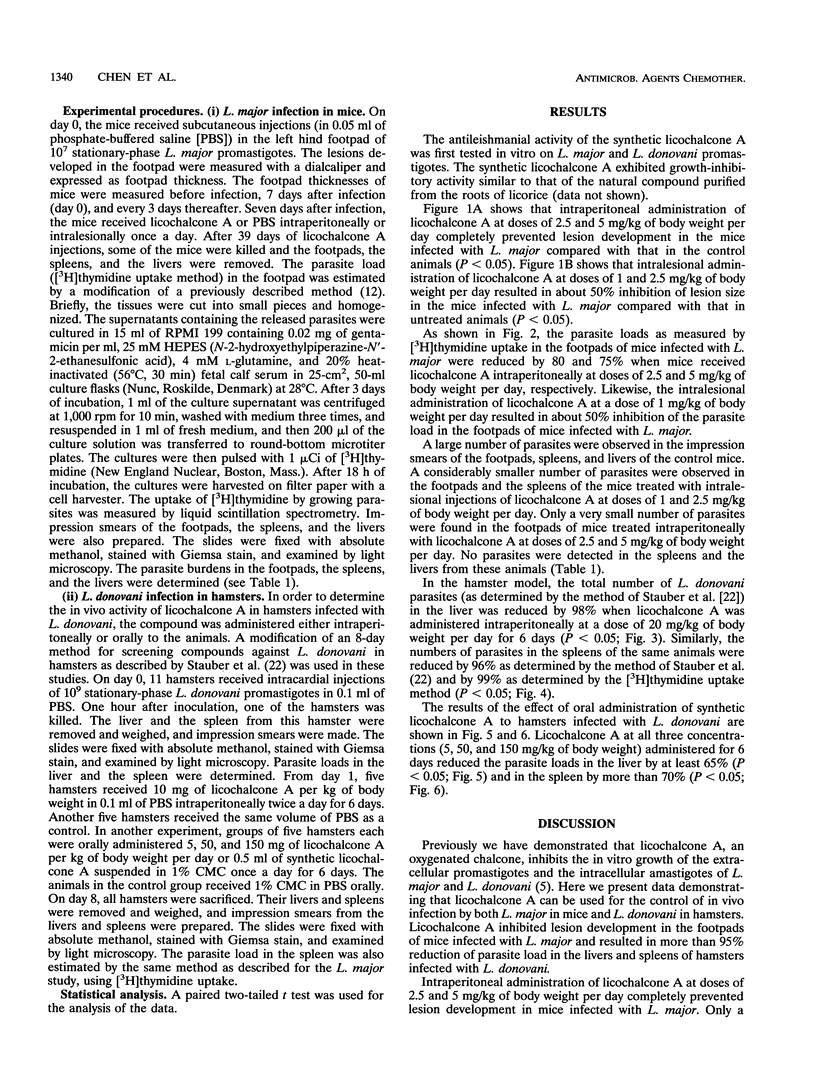
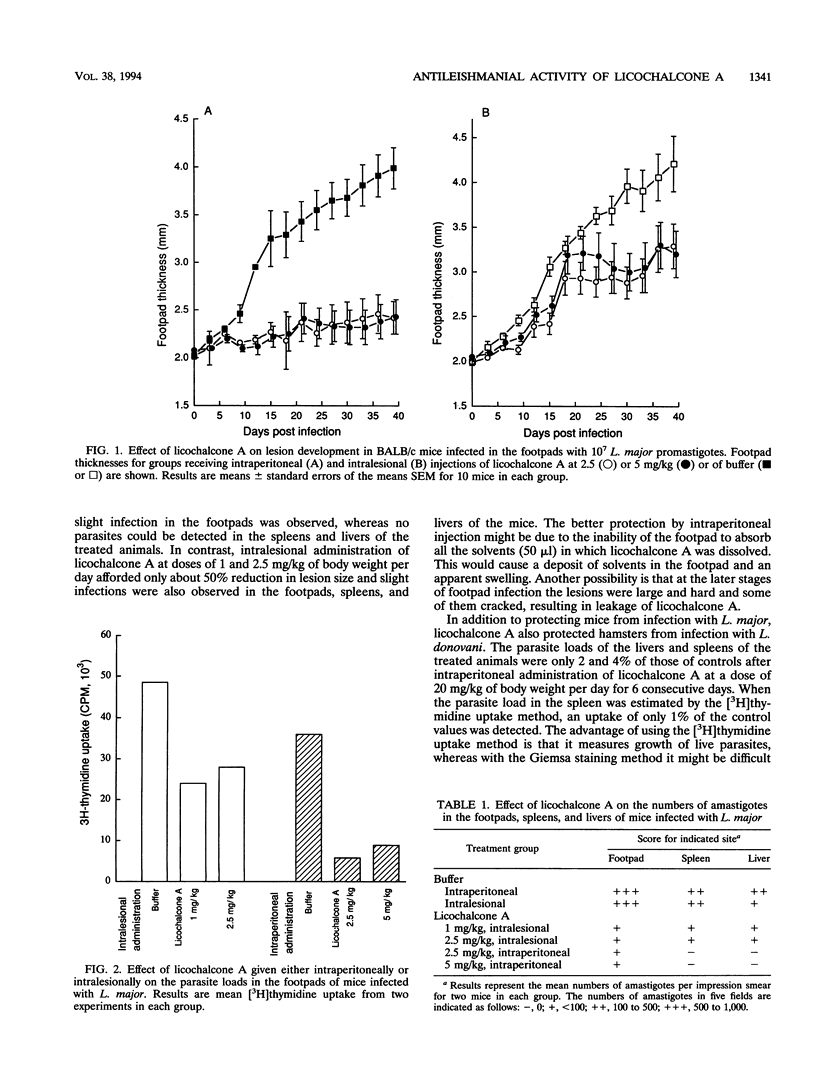
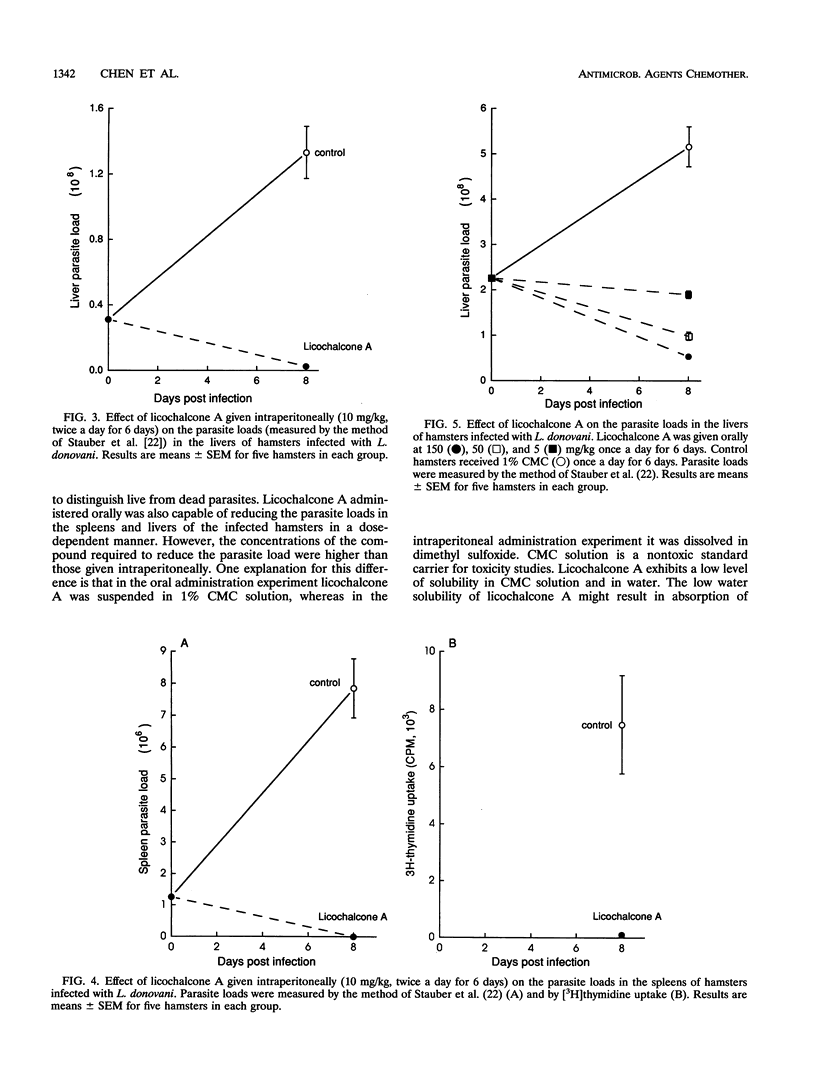
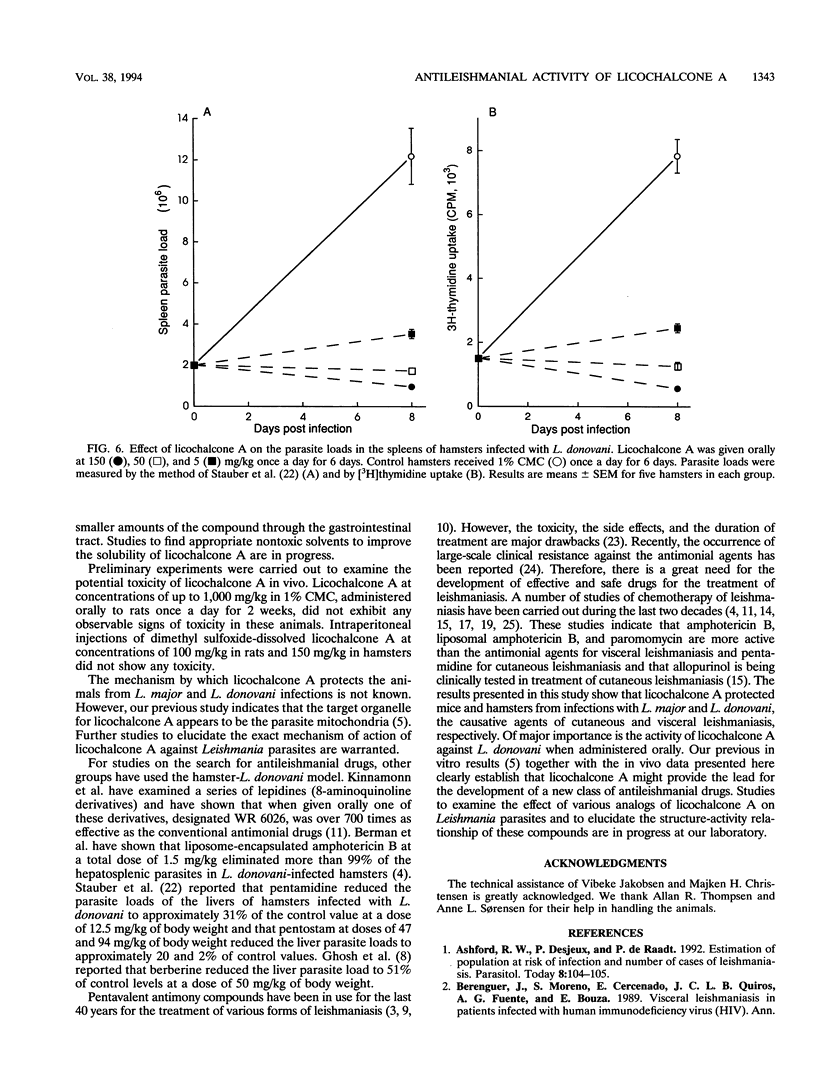
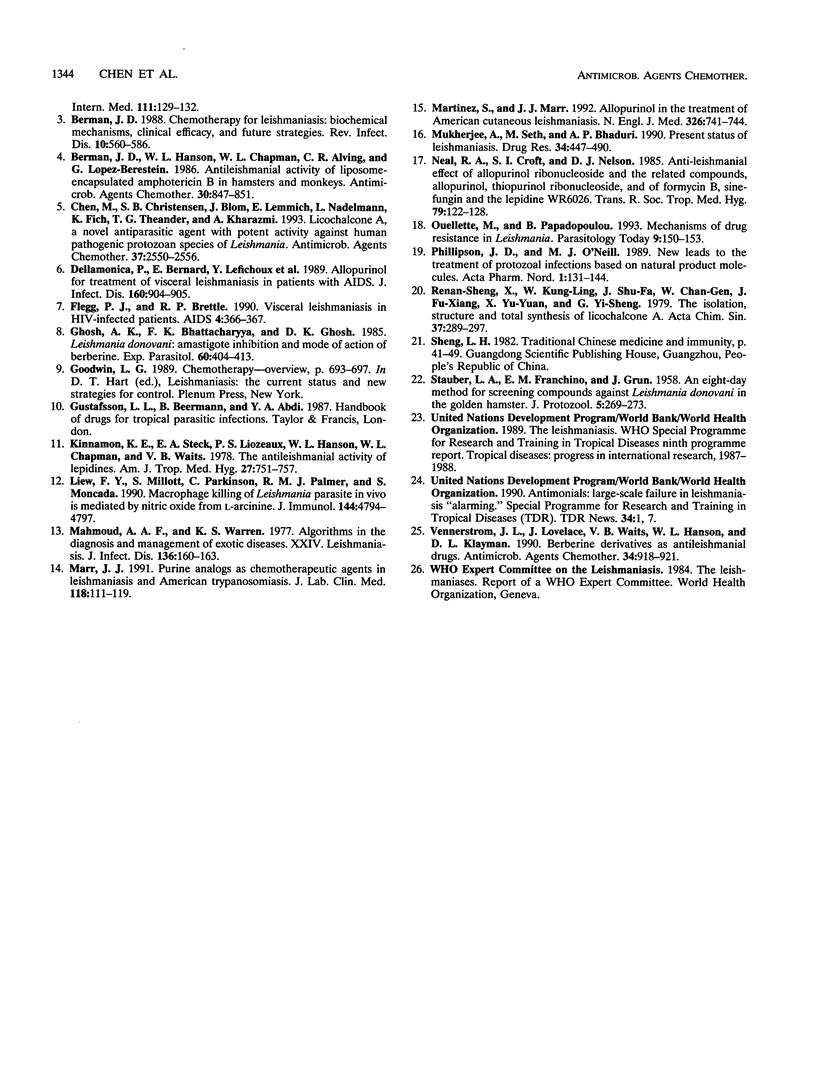
Selected References
These references are in PubMed. This may not be the complete list of references from this article.
- Ashford R. W., Desjeux P., Deraadt P. Estimation of population at risk of infection and number of cases of Leishmaniasis. Parasitol Today. 1992 Mar;8(3):104–105. doi: 10.1016/0169-4758(92)90249-2. [DOI] [PubMed] [Google Scholar]
- Berman J. D. Chemotherapy for leishmaniasis: biochemical mechanisms, clinical efficacy, and future strategies. Rev Infect Dis. 1988 May-Jun;10(3):560–586. doi: 10.1093/clinids/10.3.560. [DOI] [PubMed] [Google Scholar]
- Berman J. D., Hanson W. L., Chapman W. L., Alving C. R., Lopez-Berestein G. Antileishmanial activity of liposome-encapsulated amphotericin B in hamsters and monkeys. Antimicrob Agents Chemother. 1986 Dec;30(6):847–851. doi: 10.1128/aac.30.6.847. [DOI] [PMC free article] [PubMed] [Google Scholar]
- Chen M., Christensen S. B., Blom J., Lemmich E., Nadelmann L., Fich K., Theander T. G., Kharazmi A. Licochalcone A, a novel antiparasitic agent with potent activity against human pathogenic protozoan species of Leishmania. Antimicrob Agents Chemother. 1993 Dec;37(12):2550–2556. doi: 10.1128/aac.37.12.2550. [DOI] [PMC free article] [PubMed] [Google Scholar]
- Dellamonica P., Bernard E., Le Fichoux Y., Politano S., Carles M., Durand J., Mondain V. Allopurinol for treatment of visceral leishmaniasis in patients with AIDS. J Infect Dis. 1989 Nov;160(5):904–905. doi: 10.1093/infdis/160.5.904. [DOI] [PubMed] [Google Scholar]
- Flegg P. J., Brettle R. P. Visceral leishmaniasis in HIV-infected patients. AIDS. 1990 Apr;4(4):366–367. doi: 10.1097/00002030-199004000-00015. [DOI] [PubMed] [Google Scholar]
- Ghosh A. K., Bhattacharyya F. K., Ghosh D. K. Leishmania donovani: amastigote inhibition and mode of action of berberine. Exp Parasitol. 1985 Dec;60(3):404–413. doi: 10.1016/0014-4894(85)90047-5. [DOI] [PubMed] [Google Scholar]
- Kinnamon K. E., Steck E. A., Loizeaux P. S., Hanson W. L., Chapman W. L., Jr, Waits V. B. The antileishmanial activity of lepidines. Am J Trop Med Hyg. 1978 Jul;27(4):751–757. doi: 10.4269/ajtmh.1978.27.751. [DOI] [PubMed] [Google Scholar]
- Liew F. Y., Millott S., Parkinson C., Palmer R. M., Moncada S. Macrophage killing of Leishmania parasite in vivo is mediated by nitric oxide from L-arginine. J Immunol. 1990 Jun 15;144(12):4794–4797. [PubMed] [Google Scholar]
- Mahmoud A. A., Warren K. S. Algorithms in the diagnosis and management of exotic diseases. XXIV. Leishmaniases. J Infect Dis. 1977 Jul;136(1):160–163. doi: 10.1093/infdis/136.1.160. [DOI] [PubMed] [Google Scholar]
- Marr J. J. Purine analogs as chemotherapeutic agents in leishmaniasis and American trypanosomiasis. J Lab Clin Med. 1991 Aug;118(2):111–119. [PubMed] [Google Scholar]
- Martinez S., Marr J. J. Allopurinol in the treatment of American cutaneous leishmaniasis. N Engl J Med. 1992 Mar 12;326(11):741–744. doi: 10.1056/NEJM199203123261105. [DOI] [PubMed] [Google Scholar]
- Mukherjee A., Seth M., Bhaduri A. P. Present status of Leishmaniasis. Prog Drug Res. 1990;34:447–490. doi: 10.1007/978-3-0348-7128-0_15. [DOI] [PubMed] [Google Scholar]
- Neal R. A., Croft S. L., Nelson D. J. Anti-leishmanial effect of allopurinol ribonucleoside and the related compounds, allopurinol, thiopurinol, thiopurinol ribonucleoside, and of formycin B, sinefungin and the lepidine WR6026. Trans R Soc Trop Med Hyg. 1985;79(1):122–128. doi: 10.1016/0035-9203(85)90255-x. [DOI] [PubMed] [Google Scholar]
- Ouellette M., Papadopoulou B. Mechanisms of drug resistance in Leishmania. Parasitol Today. 1993 May;9(5):150–153. doi: 10.1016/0169-4758(93)90135-3. [DOI] [PubMed] [Google Scholar]
- Vennerstrom J. L., Lovelace J. K., Waits V. B., Hanson W. L., Klayman D. L. Berberine derivatives as antileishmanial drugs. Antimicrob Agents Chemother. 1990 May;34(5):918–921. doi: 10.1128/aac.34.5.918. [DOI] [PMC free article] [PubMed] [Google Scholar]


